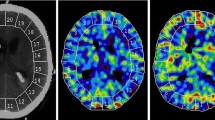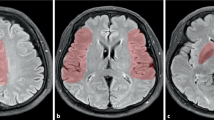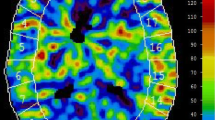Abstract
Introduction
The aim of this study was to assess regional cerebral blood flow (rCBV) in areas of CT hypoattenuation appearing in the postoperative period in patients treated for aneurysmal subarachnoid hemorrhage (SAH) using xenon-enhanced CT scanning (Xe-CT).
Methods
We analyzed 15 patients (5 male and 10 female; mean age 49.7±12.1 years) with SAH on CT performed on admission to hospital and who showed a low-density area within a well-defined vascular territory on CT scans after clipping or coiling of a saccular aneurysm. All zones of hypoattenuation were larger than 1 cm2 and showed signs of a mass effect suggesting a subacute phase of evolution. Two aneurysms were detected in two patients. Aneurysms were located in the middle cerebral artery (n=7), in the anterior communicating artery (n=6), in the internal carotid artery (n=3), and in the posterior communicating artery (n=1). Treatments were surgical (n=8), endovascular (n=2) or both (n=1). A total of 36 Xe-CT studies were performed and rCBF values were measured in two different regions of interest (ROI): the low-density area, and an area of normal-appearing brain tissue located symmetrically in the contralateral hemisphere.
Results
rCBF levels were significantly lower in the low-density area than in the contralateral normal-appearing area (P<0.01). In the low-density areas, irreversible ischemia (CBF <10 ml/100 g per minute) was present in 11/36 lesions (30.6%), ischemic penumbra (CBF 10–20 ml/100 g per minute) and oligemia (CBF 20–34 ml/100 g per minute) in 8/36 lesions (22.2%), relative hyperemia (CBF 34–55 ml/100 g per minute) in 7/36 lesions (19.4%), and absolute hyperemia (CBF >55 ml/100 g per minute) in 2/36 lesions (5.6%).
Conclusion
Our study confirmed that rCBF is reduced in new low-density lesions related to specific vascular territories. However, only about one-third of the lesions showed rCBF levels consistent with irreversible ischemia and in a relatively high proportion of lesions, rCBF levels indicated penumbral, oligemic and hyperemic areas.


Similar content being viewed by others
References
Qureshi AI, Luft AR, Sharma M, Guterman LR, Hopkins LN (2000) Prevention and treatment of thromboembolic and ischemic complications associated with endovascular procedures. Part II – clinical aspects and recommendations. Neurosurgery 46:1360–1376
Fridriksson S, Säveland H, Jakobsson K-E, Edner G, Zygmunt S, Brandt L, Hillman J (2002) Intraoperative complications in aneurysm surgery: a prospective national study. J Neurosurg 96:515–522
Weir B, Macdonald RL, Stoodley M (1999) Etiology of cerebral vasospasm. Acta Neurochir Suppl 72:27–46
Mayberg MR, Batjer HH, Dacey R, Diringer M, Haley EC, Heros RC, Sternau LL, Torner J, Adams HP Jr, Feinberg W, Thies W (1994) Guidelines for the management of aneurysmal subarachnoid hemorrhage. A statement for healthcare professionals from a special writing group of the Stroke Council, American Heart Association. Circulation 90:2592–2605
von Kummer R, Bourquain H, Bastianello S, Bozzao L, Manelfe C, Meier D, Hacke W (2001) Early prediction of irreversible brain damage after ischemic stoke at CT. Radiology 219:95–100
Inoue Y, Takemoto K, Miyamoto T, Yoshikawa N, Taniguchi S, Saiwai S, Nishimura Y, Komatsu T (1980) Sequential computed tomography scans in acute cerebral infarction. Radiology 135:655–662
Latchaw RE, Yonas H, Hunter GJ, Yuh WTC, Ueda T, Sorensen AG, Sunshine JL, Biller J, Wechsler L, Higashida R, Hademenos G (2003) Guidelines and recommendations for perfusion imaging in cerebral ischemia. A Scientific Statement for Healthcare Professionals by the Writing Group on Perfusion Imaging, from the Council on Cardiovascular Radiology of the American Heart Association. Stroke 34:1064–1104
Kaufmann AM, Firlik AD, Fukui MB, Wechsler LR, Jungries CA, Yonas H (1999) Ischemic core and penumbra in human stroke. Stroke 30:93–99
Jovin TG, Yonas H, Gebel JM, Kanal E, Chang YF, Grahovac SZ, Goldstein S, Wechsler LR (2003) The cortical ischemic core and not the consistently present penumbra is a determinant of clinical outcome in acute middle cerebral artery occlusion. Stroke 34:2426–2435
Yonas H, Sekhar L, Johnson DW, Gur D (1989) Determination of irreversible ischemia by xenon-enhanced computed tomography monitoring of cerebral blood flow in patients with symptomatic vasospasm. Neurosurgery 24:368–372
Fukui MB, Johnson DW, Yonas H, Sekhar L, Latchaw RE, Pentheny S (1992) Xe/CT cerebral blood flow evaluation of delayed symptomatic cerebral ischemia after subarachnoid hemorrhage. AJNR Am J Neuroradiol 13:265–270
Darby JM, Yonas H, Marks EC, Durham S, Snyder RW, Nemoto EM (1994) Acute cerebral blood flow response to dopamine-induced hypertension after subarachnoid hemorrhage. J Neurosurg 80:857–864
Clyde BL, Resnick DK, Yonas H, Smith HA, Kaufmann AM (1996) The relationship of blood velocity as measured by transcranial doppler ultrasonography to cerebral blood flow as determined by stable xenon computed tomographic studies after aneurysmal subarachnoid hemorrhage. Neurosurgery 38:896–905
Kim DH, Joseph M, Ziadi S, Nates J, Dannenbaum M, Malkoff M (2003) Increases in cardiac output function can reverse flow deficits from vasospasm independent of blood pressure: a study using xenon computed tomographic measurement of cerebral blood flow. Neurosurgery 53:1044–1052
Vajkoczy P, Horn P, Thome C, Munch E, Schmiedek P (2003) Regional cerebral blood flow monitoring in the diagnosis of delayed ischemia following aneurysmal subarachnoid hemorrhage. J Neurosurg 98:1227–1234
Fisher CM, Kistler JP, Davis JM (1980) Relation of cerebral vasospasm to subarachnoid hemorrhage visualized by computerized tomographic scanning. Neurosurgery 6:1–9
Wardlaw J, Sellar R (1994) A simple practical classification of cerebral infarcts on CT and its interobserver reliability. AJNR Am J Neuroradiol 15:1933–1939
Hunt W, Hess R (1968) Surgical risk as related to time of intervention in the repair of intracranial aneurysms. J Neurosurg 28:14–20
Pindzola RR, Yonas H (1998) The xenon-enhanced computed tomography cerebral blood flow method. Neurosurgery 43:1488–1492
Jones TH, Morawetz RB, Crowell RM, Marcoux FW, Fitz Gibbon SJ, DeGirolami U, Ojemann RG (1981) Thresholds of focal cerebral ischemia in awake monkeys. J Neurosurg 54:773–782
Obrist WD, Langfitt TW, Jaggi JL, Cruz J, Gennarelli TA (1984) Cerebral blood flow and metabolism in comatose patients with acute injury. Relationship to intracranial hypertension. J Neurosurg 61:241–253
Heiss W-D (2000) Ischemic penumbra: evidence from functional imaging in man. J Cereb Blood Flow Metab 20:1276–1293
Rieth KG, Fujiwara K, Di Chiro G, Klatzo I, Brooks RA, Johnston GS, O’Connor CM, Mitchell LG (1980) Serial measurements of CT attenuation and specific gravity in experimental cerebral edema. Radiology 135:343–348
Knuckey NW, Fox RA, Surveyor I, Stokes BAR (1985) Early cerebral blood flow and computerized tomography in predicting ischemia after cerebral aneurysm rupture. J Neurosurg 62:850–855
Marchal G, Young AR, Baron J-C (1999) Early postischemic hyperperfusion: pathophysiologic insights from positron emission tomography. J Cereb Blood Flow Metab 19:467–482
Conflict of interest statement
We declare that we have no conflict of interest.
Author information
Authors and Affiliations
Corresponding author
Rights and permissions
About this article
Cite this article
Fainardi, E., Tagliaferri, M.F., Compagnone, C. et al. Regional cerebral blood flow levels as measured by xenon-CT in vascular territorial low-density areas after subarachnoid hemorrhage are not always ischemic. Neuroradiology 48, 685–690 (2006). https://doi.org/10.1007/s00234-006-0111-2
Received:
Accepted:
Published:
Issue Date:
DOI: https://doi.org/10.1007/s00234-006-0111-2




